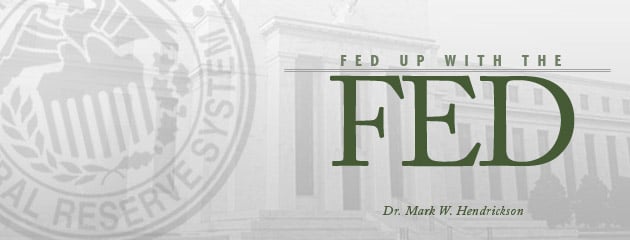
What happens to a car company that makes crummy cars, a restaurant that serves lousy food, or an insurance company that poorly serves its policyholders? Unless they mend their ways, they lose customers and eventually go out of business. That’s how a free market works.
The notable exceptions are entities that enjoy special protection from government. Thus, Uncle Sam bails out select private businesses (e.g., GM, AIG, Fannie Mae); enlarges inefficient government bureaucracies (e.g., FEMA, EPA); and preserves monopolies for poorly performing government-created institutions (e.g., the postal service and the Federal Reserve System).
Let’s take a closer look at the Fed. A thorough rethinking of Uncle Sam’s central bank is long overdue.
Congress created the Federal Reserve System in 1913 to promote stable money and banking, and to lessen the disruptive ups and downs of the business cycle. The Fed has failed dismally.
Under the Fed’s supervision, boom-bust cycles have continued. Three of them—the Great Depression, the stagflationary period from 1974-82, and the current “Great Recession”—have been devastating. Bank failures have occurred in alarmingly high numbers. The dollar has lost 95-98 percent of its purchasing power.
Tragically, the Fed appears to have learned little from its mistakes. Its current policy of “quantitative easing” continues its long tradition of creating bubbles by deliberately implementing inflationary policies. Citing the official Consumer Price Index, the Fed justifies its aggressive inflationary QE2 policy by asserting that price inflation is too low.
People living in the real world may disagree. In the last year, the Commodity Research Bureau’s food index has risen 27 percent; cotton’s price has more than doubled to an all-time high; and oil and gasoline prices have posted double-digit gains. The costs of eating, driving, and wearing clothes are trending higher at the very time the Fed plans to inject hundreds of billions of dollars (trillions, if needed) to prop up Washington and Wall Street.
What concerns me about the Fed’s current course (apart from the danger it poses to the purchasing power of our income and savings) is the totally arbitrary way in which it is proceeding. The Fed has arrogated unprecedented discretionary powers to itself.
Indeed, the Fed now has a free hand to create however much money it wants and buy whatever financial assets it chooses, whether government or private or even foreign. There is no oversight or accountability. Even the Inspector General for the Federal Reserve, the Fed’s official watchdog, has been left in the dark. (Check out this astonishing congressional testimony.)
It is anomalous that there should be such a powerful, unrestrained institution as the Fed in our body politic. Its awesome, arbitrary powers make a mockery of constitutional checks and balances; it threatens not only our money, but liberty itself.
The chairman of the Fed is commonly referred to as the second most powerful person in the country. In a democratic republic, should the second most powerful policymaker be unelected?
Why won’t Congress at least audit the Fed? Rep. Ron Paul has proposed this for years, but a majority of his colleagues seem afraid to take this simple, prudent step. This is the same Congress that routinely demands microscopically detailed access to the financial records of private-sector corporations. Why the double standard?
If there is going to be a central bank (and that is a big “if”), it needs to have a simpler focus than the Fed’s current mission statement. The 1970 amendments to the Federal Reserve Act state that the Fed should “promote effectively the goals of maximum employment, stable prices, and moderate long-term interest rates.” These goals are misguided and unattainable.
First, the premise that the central bank can promote employment is erroneous. It is based on a spurious academic theory called the Phillips curve that posits a supposed tradeoff between inflation and employment. Unemployment is fundamentally a price problem, not a monetary problem; therefore, unemployment can only be cured by the presence of a free market in wages. Employment is not the responsibility of a central bank.
Second, central bank tampering with interest rates is the fundamental cause of the artificial boom-bust cycle; thus, the Fed or any successor institution should forever cease from tampering with interest rates.
Finally, focusing on “stable prices” is looking at the problem backwards. The Fed shouldn’t try to influence prices any more than a nurse should influence the readings on a thermometer. The “fever” that causes prices to rise and purchasing power to fall is unstable, unreliable money. “Heal” the money, and prices will take care of themselves.
The sole mission of the Fed or any alternative guardian of our country’s money should be to preserve the integrity of the monetary unit. That means an end to fiat money and a return to constitutional, honest money. The Fed, as currently constituted, must go.

